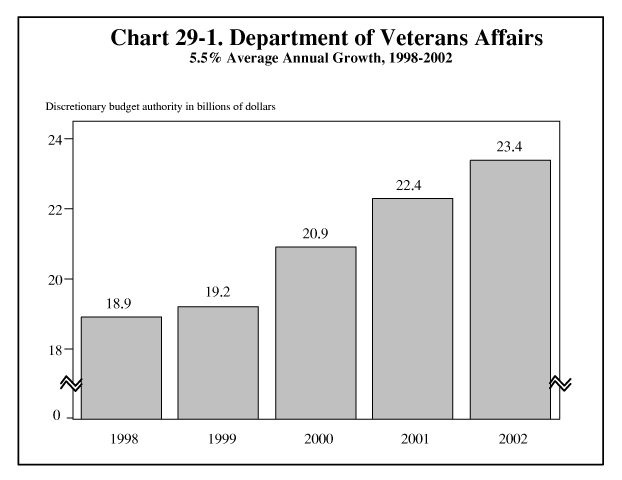
- Afghanistan
- Africa
- Budget Management
- Defense
- Economy
- Education
- Energy
- Environment
- Global Diplomacy
- Health Care
- Homeland Security
- Immigration
- International Trade
- Iraq
- Judicial Nominations
- Middle East
- National Security
- Veterans
|
Home >
News & Policies
|
29. Department of Veterans Affairs
|
Initiatives
The President's Budget will rejuvenate the Department of Veterans Affairs' (VAs') efforts to ensure the timely and accurate processing of veterans' disability compensation claims. It will fully implement new legislation that strengthens VA's "duty to assist" veterans in preparing their claims and a regulation that adds diabetes to the list of presumptive conditions that are associated with exposure to herbicides. The budget will fully fund the Veterans Benefits Administration's (VBA) additional workload for this initiative and assumes that VBA will develop a vision for future benefit delivery that incorporates and harnesses paperless technology. Part of this effort to modernize will be for VBA to complete the consolidation of aging data centers into its state-of-the-art facility in Austin, Texas.

Redirected Resources
The National Defense Authorization Act, 2001, authorized a new Department of Defense (DOD) benefit for military retirees over age 64 who have Medicare coverage. These retirees will be able to use their own private doctors for free care and receive a generous drug benefit. Currently, 240,000 of these retirees are enrolled with VA for care. The budget assumes that 27 percent of them will switch to the DOD benefit in this first year, shifting $235 million in VA liabilities to DOD.
The budget also includes legislation for several proposals that will yield net mandatory savings totaling $2.5 billion over the next 10 years. The first eliminates VA's vendee home loan program. It is unrelated to VA's mission because it allows the general public to obtain a direct loan from VA to purchase a home that VA has acquired when a veteran defaults on a loan. The general public may obtain financing from various other public and private institutions for this purpose. Other proposals would extend permanently certain mandatory savings authorities that would otherwise expire over the next several years.
Potential Reforms
Both the budget and the President's National Security Directive on Military Quality of Life reflect the Administration's commitment to improve VA health care for those veterans eligible for treatment in the system by enhancing access to timely, high-quality care. The President will convene a Veterans Health Care Task Force composed of officials and clinicians from VA and DOD, leaders of veterans and military service organizations, and leaders in health care quality to make recommendations for improvements.
To avoid duplication of benefits and enhance the quality and continuity of care, the Administration will focus on providing high-quality health care through a single source. Over 700,000 military retirees (all ages) are enrolled in both the DOD and VA health systems and may use either whenever they choose. As a result, DOD and VA encounter problems in allocating the necessary resources due to their difficulty estimating the number of people that will obtain health care services in each of the systems. The Administration will seek legislation to ensure that DOD beneficiaries who are also eligible for VA medical care enroll with only one of these agencies as their health care program. In addition, to ensure high-quality care and expanded access for the Nation's highest priority veterans, VA will focus its attention on treating disabled and low-income veterans.
VA has begun the assessment phase of an infrastructure reform initiative that will result in a health care system with enhanced capabilities to treat veterans with disabilities or lower incomes living in underserved geographic areas. Savings from the disposal of underused VA facilities will support these improvements. As VA awaits the recommendations from this multi-year assessment (referred to as CARES), it will continue to use expanded sharing agreements and contracting authorities with other health care providers.
VA will continue to reform its information technology. It will improve coordination among its administrations to plan for, implement, and use information technology to serve veterans. Reforms will include developing a common technological architecture, establishing common data definitions, and coordinating systems across VA, to improve cost-effectiveness and delivery of benefits and services to veterans.


